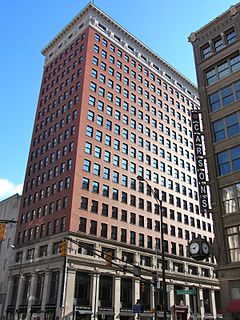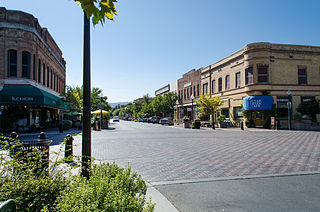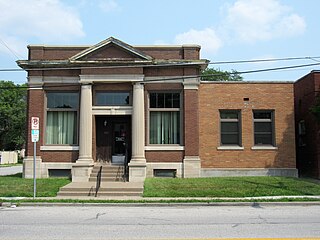
The Fairlie–Poplar Historic District is part of the central business district in downtown Atlanta. It is named for the two streets that cross at its center, northeast-only Fairlie and southeast-only Poplar. Fairlie–Poplar is immediately north of Five Points, the definitive centerpoint and longtime commercial heart of Atlanta. It is roughly bounded on the southwest by Marietta Street, on the southeast by Peachtree Street or Park Place, on the northeast by Luckie Street or Williams Street, and on the northwest by Cone Street or Spring Street. It has smaller city blocks than the rest of the city, and the streets run at a 40° diagonal.

The Downtown New London Historic District, also known as the Waterfront Historic District, refers to 78 acres (32 ha) with 223 contributing buildings along the waterfront of New London, Connecticut. It was added to the National Register of Historic Places (NRHP) in 1979, with 190 buildings and 60 acres (24 ha). The district was expanded in 1988, adding 18 acres (7.3 ha) and 33 buildings.

The Barnes and Thornburg Building is a high rise in Indianapolis, Indiana originally known as the Merchants National Bank Building. In 1905, the Merchants National Bank and Trust Company engaged the architectural firm of D. H. Burnham & Company of Chicago to design a new bank headquarters on the southeastern corner of the Washington and Meridian streets, the most important intersection in Indianapolis. Initial occupancy of the lower floors took place in 1908, while the upper floors were not completed until 1912.

The Downtown Winters Historic District, also known as the Main Street Historic District, is a historic district in Winters, Yolo County, California which includes the block of Main Street between Railroad Avenue and First Street. The district is the commercial center of Winters and includes commercial buildings built between the 1870s and 1912. Twenty buildings are included in the district, thirteen of which are contributing buildings. The most prominent building in the district is the DeVilbiss Hotel, which was built in 1899 and designed by A.A. Cook of Sacramento. The Bank of Winters Business Block, a 1904 structure located across from the hotel, is also considered a centerpiece of the district. Two buildings in the district date from the founding of Winters in the mid-1870s: the Opera House and the Chulick Market. The remaining buildings in the district were mainly built in two waves, one in the 1890s and one from 1906 to 1912.

The Harmonie Centre, also known as the Breitmeyer-Tobin Building, is an eight-story commercial building located at 1308 Broadway Street in Downtown Detroit, Michigan. It is part of the Broadway Avenue Historic District. It is also known as the Tobin Building. The building was listed on the National Register of Historic Places in 1980. The east necklace of downtown links Grand Circus and the stadium area to Greektown along Broadway. The east necklace contains a sub-district sometimes called the Harmonie Park District, which has taken on the renowned legacy of Detroit's music from the 1930s through the 1950s and into the present.

The Central Square Historic District is a historic district encompassing the central town common of the city of Waltham, Massachusetts, and several commercial buildings facing the common or in its immediate vicinity. The common is bounded by Carter, Moody, Main, and Elm Streets; the district includes fourteen buildings, which are located on Main, Elm, Lexington, and Church Streets, on the north and east side of the common. The district was listed on the National Register of Historic Places in 1989.

The Fort Madison Downtown Commercial Historic District has a collection of late-19th century store fronts centered on Ave. G, from 6th to 9th Street, and Ave. H from 7th to 9th, in Fort Madison, Iowa. It was listed on the National Register of Historic Places in 2007.

Valparaiso has retained an active downtown. It remains a mix of government, retail and business center, with a mixed residential and service area. Numerous economic changes have not changed the basic character, historic courthouse area. The historic district retains the distinctive turn-of-the-19th-century architecture, supporting numerous small specialty shops, shaded sidewalks, and a people friendly environment. The Downtown District, is anchored on the Porter County Courthouse. It includes 14-blocks surrounding the square, bounded on the north by Jefferson Street, on the east by Morgan Street, on the south by Monroe Street, and on the west by Napoleon Street.

Northwest Davenport Savings Bank is a historic building located in a commercial district in the old northwest section of Davenport, Iowa, United States. It has been listed on the National Register of Historic Places since 1984.

The Downtown Rock Springs Historic District is a 15.97-acre (6.46 ha) historic district that was listed on the National Register of Historic Places in 1994. It is roughly bounded by K, 4th, C, 2nd, A, and 5th Streets in downtown Rock Springs, Wyoming.

The West Downtown Rockford Historic District is a set of forty-four buildings in Rockford, Illinois, United States that reflect the downtown district of the city west of the Rock River. Of these buildings, forty-one contribute to the historical significance of the district.

The El Dorado Commercial Historic District encompasses the historic commercial heart of downtown El Dorado, Arkansas. The city serves as the seat of Union County, and experienced a significant boom in growth during the 1920s, after oil was discovered in the area. The business district that grew in this time is anchored by the Union County Courthouse, at the corner of Main and Washington Streets, where the Confederate memorial is also located. The historic district listed on the National Register of Historic Places in 2003 includes the city blocks surrounding the courthouse, as well as several blocks extending east along Main Street and south along Washington Street. Most of the commercial buildings are one and two stories in height and are built of brick. Notable exceptions include the Exchange Bank building, which was, at nine stories, the county's first skyscraper, and the eight-story Murphy Oil building. There are more than forty contributing properties in the district.

Hedge Block, also known as Johnson-Rasmussen Building, is a historic commercial building located in the central business district of Burlington, Iowa, United States. It was individually listed on the National Register of Historic Places in 1982. It was included as a contributing property in the West Jefferson Street Historic District in 1991 and in the Downtown Commercial Historic District in 2015.

The First National Bank of Mason City, also known as Norwest Bank Building and City Center of Mason City, is a historic building located in Mason City, Iowa, United States. It was designed by the Des Moines architectural firm of Liebbe, Nourse & Rasmussen, and it was the only Mason City commission for this firm. Completed in 1911, it was constructed by C.E. Atkinson of Webster City, Iowa who had built several other H.F. Liebbe designs. The 6½-story building follows the Early Commercial style. It features modestly decorated main floor and attic level with five floors of rather plain brick construction in between. The bank occupied most of the first floor and some of the office space above, while the other office space was taken up by professional offices. By the 1960s the bank occupied the whole building. John Dillinger, Baby Face Nelson, John Hamilton and Tommy Carroll robbed the bank on March 13,1934 and stole about $50,000. Dillinger was wounded in an exchange of gunfire during the heist. The building to the north of the bank was torn down in 1982 and a two-story annex to the bank replaced it. The bank building was individually listed on the National Register of Historic Places in 1997, and as a contributing property in the Mason City Downtown Historic District in 2005. City Center of Mason City Inc. bought the building in 1995, and remodeled it into apartments and offices.

The United Bank Building is a historic commercial building at 19-21 Main Street in downtown New Milford, Connecticut. Designed by Wilson Potter and built 1902-04, it is a prominent local example of Classical Revival architecture, built to house two banks whose previous buildings had been destroyed in a devastating fire. The building was listed on the National Register of Historic Places in 1982, and is a contributing element of the New Milford Center Historic District.

The Holland Downtown Historic District is a commercial historic district located along Eighth Street from just east of College Avenue to River Avenue, and along and River Avenue from Ninth Street to just north of Eighth Street in Holland, Michigan. The district was listed on the National Register of Historic Places in 1990.

The Dublin Commercial Historic District is a 32 acres (13 ha) historic district roughly centered on Jackson Ave. and Lawrence St. in Dublin in Laurens County, Georgia. It was listed on the National Register of Historic Places in 2002. The district included 76 contributing buildings, one contributing structure, and one contributing object.

The Downtown Salem Historic District in Salem, South Dakota is a small historic district which was listed on the National Register of Historic Places in 2004. It contained just three contributing buildings, at 140, 200 and 201 N. Main.

























